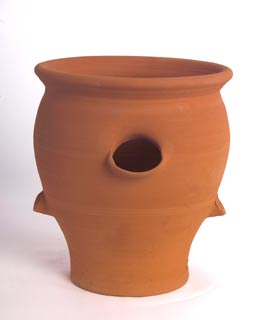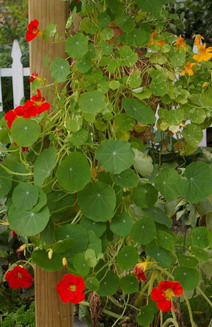|
A Strawberry Herb Planter
The wonderful multi holed, terra cotta pot known as a strawberry planter is an excellent way of growing a collection of herbs. Although in mild climates these planters do grow a fine crop of strawberries, their ability to overwinter in a more cold temperate climate like mine, is a bit suspect. Anywhere you happen to live they do make a great container to keep in the sunniest spot near your kitchen to supply you with a season's full of fresh herbs. The length of that season will, of course, depend on your location. In my part of the world most herbs certainly won't overwinter in this container and as a result I tend to use it for annual herbs such as the many wonderful Basils.
 What Kind of Soil? One of the big advantages of these soil mixes is their relatively light weight, making them easy to carry home or even up the elevator to your 20th floor condo. It helps greatly to pre-wet most of these soils and the instructions on the bag will usually tell you that. You can attempt this in the bag the mixture came in but that usually is bit messy. Better to pour some of the soil into a bucket or wheelbarrow and then add water gradually as you stir the mixture with a trowel. When it is nicely damp you can start filling up the planter. The mixture will settle and compact a fair amount when filling and when you add more water at the end of the process, so firm it into the pot a reasonable amount but remember that you are not making concrete here and that your plant's roots have to be able to grow easily through this mixture. When the pot is filled and reasonably well watered sit back and call it a good day's work.
What Kind of Soil? One of the big advantages of these soil mixes is their relatively light weight, making them easy to carry home or even up the elevator to your 20th floor condo. It helps greatly to pre-wet most of these soils and the instructions on the bag will usually tell you that. You can attempt this in the bag the mixture came in but that usually is bit messy. Better to pour some of the soil into a bucket or wheelbarrow and then add water gradually as you stir the mixture with a trowel. When it is nicely damp you can start filling up the planter. The mixture will settle and compact a fair amount when filling and when you add more water at the end of the process, so firm it into the pot a reasonable amount but remember that you are not making concrete here and that your plant's roots have to be able to grow easily through this mixture. When the pot is filled and reasonably well watered sit back and call it a good day's work. What and When to Plant! Let it drain and settle for a day or so while you go out and purchase the herbs that you intend to plant in it. There are some wonderful compact Basils that will probably give you the greatest satisfaction. In some of the lower holes you might try some of the Oreganos because they tend to trail a bit and will cascade down the side of the pot. There are an amazing array of different flavoured mints that will thrive in these containers and indeed this is a great place to grow them as they will be contained by the container and not run rampant over your whole garden. There probably isn't anything you shouldn't try, after all gardening should always be a learning experience as well as a treat for the senses. Whether you start from transplants or from seeds, just enjoy watching these herbs spill down the sides and add to the inherent beauty of these containers.
|

